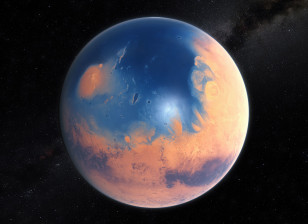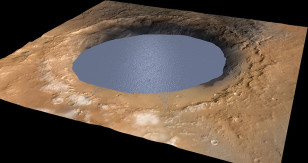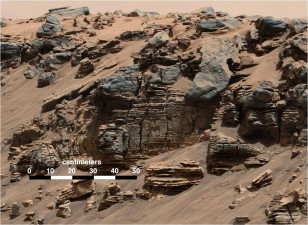
An artist’s impression shows how Mars may have looked about four billion years ago. (ESO/M. Kornmesser/N. Risinger/skysurvey.org)
Previous studies have indicated that liquid water once flowed on the Red Planet. Some even suggested that at one time, Mars held great quantities of H2O. But scientists now believe that most of the Planet’s current water supply exists solely in ice or vapor form.
In a recent analysis of data produced by NASA’s Mars Rover Curiosity, researchers at the University of Copenhagen’s Niels Bohr Institute found evidence that there may be salty but liquid water closer to the surface of Mars than previously thought.
Writing in the journal Nature, the researchers said they found the presence of the salt calcium perchlorate in the Martian soil. Salt can lower the freezing point of water so it doesn’t freeze into ice so easily, which is why it’s often used to melt ice on sidewalks and roadways.
Morten Bo Madsen, associate professor and head of the Mars Group at the Niels Bohr Institute, said that under the right conditions the calcium perchlorate can absorb water vapor from the atmosphere.
Measurements he and his colleagues made from Curiosity’s weather monitoring station have indicated that these ‘right conditions’ just happen to occur at night and right after sunrise during winter on Mars.

The researchers believe that Gale Crater was a large lake between 3.5 and 2.7 billion years ago. (NASA/JPL/Caltech/ESA/DLR/MSSS)
At night, some of Mars’ atmospheric moisture is concentrated into frost on the planet’s surface, much like it does here on Earth.
But when the calcium perchlorate within the Martian soil absorbs the moisture, Madsen said it forms a brine that lowers the freezing point and turns it into a liquid. That liquid water then seeps through and down the porous soil.
“Over time, other salts may also dissolve in the soil. And now that they are liquid, they can move and precipitate elsewhere under the surface,” explained Madsen in a Neil Bohr Institute press release.
Past observations made with Curiosity’s stereo camera showed areas of Mars that had the attributes of an ancient riverbed, indicating that plenty of running water once flowed on the Red Planet.
Some new close-up photos taken by the rover while traveling across Gale Crater on its way to Mount Sharp have revealed swaths of sedimentary deposits that were found lying as ‘plates’ piled atop one another and leaning toward the Martian mountain.

Very fine-grained sediments, which slowly fell down through the water, were deposited right at the bottom of the crater lake. The sediment plates at the bottom are level, which indicates the entire Gale Crater may have once held a large lake. (NASA/JPL, MSSS)
“These kind of deposits are formed when large amounts of water flow down the slopes of the crater and these streams of water meet the stagnant water in the form of a lake. When the stream meets the surface, the solid material carried by the stream falls down and is deposited in the lake just at the lake shore,” said Madsen.
While the sediment layers that the Curiosity observed were found leaning toward Mt. Sharp, the same type of deposits located on the bottom of the crater are level – something that Madsen said indicates that at one time, the entire Gale Crater may have been a large lake.
While Madsen and his colleagues may have found signs of liquid water on Mars, a key ingredient for life, as we know it, to emerge and survive, they also assert that any potential life forms that might be able to endure the planet’s harsh conditions would probably be wiped out by the Red Planet’s powerful cosmic radiation. Based on that, Madsen and his team said it’s unlikely that life will be found on a planet so cold and dry.























Atmospheric Moisture
For atmosphere, water, and gravity to show some sign of being on Mars, Mars internal fire must still be alive, no matter how small it is; otherwise, mars would have no evidence of atmosphere, water, or gravity — for it is a planet’s internal fire that makes all these things possible; on earth too…